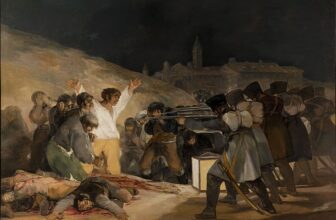
The Difference Between the Renaissance and Baroque Periods
Art and history are intertwined in the evolution of human culture, and two significant periods that showcase this transformation are the Renaissance and Baroque eras. Spanning roughly from the 14th to the 17th century, these periods mark profound shifts in artistic expression, cultural values, and intellectual thought. While both the Renaissance and Baroque periods are characterized by artistic brilliance, they exhibit distinct features that set them apart. In this article, we will explore the divergent aspects of these two fascinating periods and delve into their unique contributions to the art world.
The Renaissance: A Rebirth of Humanism and Classical Ideals The Renaissance, which emerged in 14th-century Italy and later spread across Europe, was a period characterized by a renewed interest in classical knowledge and humanism. It marked a transition from the medieval worldview to a more human-centered perspective. Here are some key features of the Renaissance:
- Humanism and Individualism: The Renaissance placed emphasis on the individual, promoting the idea that human beings have the capacity to shape their destinies. Scholars and artists focused on the study of classical literature, philosophy, and human potential. Humanist thinkers like Petrarch and Erasmus celebrated the value of education and the pursuit of knowledge.
- Naturalism and Realism: Renaissance artists sought to depict the world as faithfully as possible, emphasizing naturalism and realism. They studied human anatomy, perspective, and light to create more lifelike representations in their paintings and sculptures. Artists such as Leonardo da Vinci and Michelangelo exemplify this pursuit of naturalism.
- Linear Perspective: Renaissance artists mastered the technique of linear perspective, allowing them to create depth and dimension in their artworks. By using vanishing points and converging lines, they achieved a sense of three-dimensionality on a two-dimensional canvas.
- Classicism: Inspired by ancient Greece and Rome, Renaissance artists drew heavily from classical motifs, forms, and themes. They embraced symmetry, balance, and harmony in their compositions. Architecture, such as the works of Filippo Brunelleschi, demonstrated a return to classical proportions and principles.
The Baroque: Drama, Emotion, and Ornate Grandeur The Baroque period, which followed the Renaissance, emerged in the late 16th century and continued into the 18th century. It represented a departure from the balanced and rational ideals of the Renaissance and embraced a more dynamic and emotionally charged aesthetic. Here are some key features of the Baroque period:
- Emotion and Dramatic Expression: Baroque art aimed to evoke strong emotional responses in viewers. Artists employed dynamic compositions, intense contrasts of light and shadow (known as chiaroscuro), and exaggerated gestures to convey drama and heightened emotion. The works of Caravaggio exemplify this theatricality.
- Ornate Grandeur: Baroque art was characterized by elaborate ornamentation and a sense of opulence. Artists and architects sought to create awe-inspiring and monumental works. Lavish decorations, intricate details, and the use of rich materials were common features seen in Baroque sculptures, paintings, and architecture.
- Light and Illusion: Baroque artists utilized light as a tool to create drama and draw the viewer’s attention. Painters such as Rembrandt and Vermeer mastered the manipulation of light and shadow, giving their works a sense of depth and a luminous quality.
- Dynamic Movement: Baroque art embraced the notion of movement and energy. Figures in paintings and sculptures were depicted in dynamic poses, often caught in the midst of action. This conveyed a sense of vitality and movement, capturing fleeting moments frozen in time.
Let us explore some prominent characteristics of Renaissance painting:
- Leonardo da Vinci’s “Mona Lisa” (1503-1506): Leonardo da Vinci, a polymath artist, perfectly embodies the spirit of the Renaissance. His masterpiece, the “Mona Lisa,” captures the essence of Renaissance ideals. The painting showcases naturalism, meticulous attention to detail, and the use of sfumato, a technique that creates a soft, smoky effect. The portrait’s enigmatic smile has fascinated viewers for centuries.
- Raphael’s “The School of Athens” (1509-1511): Raphael’s fresco masterpiece, “The School of Athens,” epitomizes the harmonious balance and idealized beauty of the Renaissance. The painting depicts an assembly of ancient philosophers and intellectuals in a grand architectural setting. Through the use of linear perspective, Raphael creates depth, while his attention to anatomical accuracy showcases the influence of classical art.
Let us explore some notable characteristics of Baroque painting:
- Caravaggio’s “The Calling of St. Matthew” (1599-1600): Caravaggio, a prominent Baroque painter, revolutionized art with his dramatic use of light and shadow. In “The Calling of St. Matthew,” Caravaggio captures a powerful moment of divine intervention. Through his chiaroscuro technique, the scene is dramatically illuminated, drawing attention to the contrast between light and dark. The painting’s intense realism and emotional impact are quintessential Baroque features.
- Peter Paul Rubens’ “The Descent from the Cross” (1612-1614): Rubens, one of the most influential Baroque painters, excelled in capturing movement, passion, and grandeur. In “The Descent from the Cross,” Rubens portrays the biblical scene with vibrant colors, dynamic compositions, and a sense of emotional turmoil. The painting’s monumental scale and dramatic gestures evoke a profound sense of pathos and evoke a deep emotional response.
While both the Renaissance and Baroque periods mark significant milestones in the history of art, they diverge in terms of their underlying philosophies and artistic approaches. The Renaissance celebrated humanism, the individual, and the revival of classical ideals, promoting naturalism, realism, and balance. On the other hand, the Baroque period was characterized by drama, emotional intensity, and ornate grandeur, with a focus on dynamic movement, illusion, and the evocation of strong emotions.
These distinct characteristics make the Renaissance and Baroque periods captivating and unique in their contributions to art history. Their legacies continue to inspire artists and enthusiasts alike, reminding us of the rich tapestry of human creativity and the ever-evolving nature of artistic expression.






